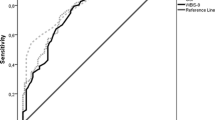Abstract
Current measures of internalized weight bias assess factors such as responsibility for weight status, mistreatment because of weight, etc. A potential complementary approach for assessing internalized weight bias is to examine the correspondence between individuals’ ratings of obese people, normal weight people, and themselves on personality traits. This investigation examined the relationships among different measures of internalized weight bias, as well as the association between those measures and psychosocial maladjustment. Prior to the beginning of a weight loss intervention, 62 overweight/obese adults completed measures of explicit and internalized weight bias as well as body image, binge eating, and depression. Discrepancies between participants’ ratings of obese people in general and ratings of themselves on both positive and negative traits predicted unique variance in measures of maladjustment above a traditional assessment of internalized weight bias. This novel approach to measuring internalized weight bias provides information above and beyond traditional measures of internalized weight bias and begins to provide insights into social comparison processes involved in weight bias.
Similar content being viewed by others
References
Carels, R. A., Hinman, N., Oehlhof, M. W., Gumble, A., Koball, A., & Young, K. M. (2011). The self protective nature of implicit identity and its relationship to weight bias and short-term weight loss. Obesity Facts, 4, 278–283.
Carels, R. A., Young, K. M., Coit, C., Harper, J., Gumble, A., Wagner, M., et al. (2009). Internalized weight stigma and its ideological correlates among treatment-seeking adults. Eating and Weight Disorders, 14, 92–97.
Cash, T. (2000). The multidimensional body self-relations questionnaire. MBSRQ User’s Manual, (pp. 1–12). Norfolk, VA: Old Dominion University.
Celio, A. A., Wilfley, D. E., Crow, S. J., Mitchell, J., & Walsh, B. T. (2004). A comparison of the binge eating scale, questionnaire for eating and weight patterns-revised, and eating disorder examination questionnaire with instructions with the eating disorder examination in the assessment of binge eating disorder and its symptoms. International Journal of Eating Disorders, 36, 434–444.
Cramer, P., & Steinwert, T. (1998). This is good, fat is bad: How early does it begin? Journal of Applied Developmental Psychology, 19, 606–611.
Crandall, C. S. (1994). Prejudice against fat people: Ideology and self-interest. Journal of Personality and Social Psychology, 66, 882–894.
Crandall, C. S., Tsang, J., Harvey, R. D., & Britt, T. W. (2000). Group identity-based protective strategies: The stigma of race, gender, and garlic. European Journal of Social Psychology, 30, 355–381.
Degher, D., & Hughes, G. (1999). The adoption and management of “fat” identity. In J. Sobal & D. Maurer (Eds.), Interpreting weight: The social management of fatness and thinness (pp. 11–27). New York: Aldine de Gruyter.
Durso, L. E., & Latner, J. D. (2008). Understanding self-directed stigma: Development of the weight bias Internalization scale. Obesity, 16, s80–s86.
Festinger, L. (1954). A theory of social comparison processes. Human Relations, 7, 117–140.
Gormally, J., Black, S., Dastin, S., & Rardin, D. (1982). The assessment of binge eating severity among obese persons. Addictive Behaviors, 7, 47–55.
Karpinski, A. (2004). Measuring self-esteem using the implicit associations test: The role of the other. Personality and Social Psychology Bulletin, 30, 22–34.
Klesges, R. C., Klem, M. L., Hansoon, C. L., Eck, L. H., Ernst, J., et al. (1990). The effects of applicant’s health status and qualifications on simulated hiring decisions. International Journal of Obesity, 14, 527–535.
Lillis, J., Loumo, J. B., Levin, M. E., & Hayes, S. C. (2010). Measuring weight self-stigma: The weight self-stigma questionnaire. Obesity, 18, 971–976.
Marcus, B. H., Wing, R. R., & Hopkins, J. (1988). Obese binge eaters: Affect, cognitions, and response to behavioral weight control. Journal of Consulting and Clinical Psychology, 56, 433–439.
Puhl, R. M., & Heuer, C. A. (2009). The stigma of obesity: A review and update. Obesity, 17, 1–24.
Puhl, R. M., Moss-Racusin, C. A., & Schwartz, M. B. (2007). Internalization of weight bias: Implications for binge eating and emotional well-being. Obesity, 15, 19–23.
Puhl, R. M., Schwartz, M., & Brownell, K. D. (2005). Impact of perceived consensus on stereotypes about obese people: A new approach for reducing bias. Health Psychology, 24, 517–525.
Quinn, D. M., & Crocker, J. (1998). Vulnerability to the affective consequences of the stigma of overweight. In J. K. Swim & C. Stangor (Eds.), Prejudice: The target’s perspective (pp. 125–143). San Diego, CA: Academic Press.
Radloff, L. S. (1977). The CES-D scale: A self-report depression scale for research in the general population. Applied Psychological Measurement, 1, 385–401.
Suls, J., & Martin, R. (2001). Social comparison processes in the physical health domain. In A. Baum, T. A. Revenson, & J. L. Singer (Eds.), Handbook of health psychology (pp. 195–208). Mahwah, NJ: Lawrence Erlbaum Associates.
Tajfel, H. (1981). Human groups and social categories. Cambridge: Cambridge University Press.
Taylor, S. E., & Brown, J. D. (1988). Illusion and well-being: A social psychological perspective on mental health. Psychological Bulletin, 103, 193–210.
Teachman, B. A., & Brownell, K. D. (2001). Implicit anti-fat bias among health professionals: Is anyone immune? International Journal of Obesity, 25, 1525–1531.
Wang, S. S., Brownell, K. D., & Wadden, T. A. (2004). The influence of the stigma of obesity on overweight individuals. International Journal of Obesity, 28, 1333–1337.
Conflict of interest
The authors have no conflicts of interest to declare.
Author information
Authors and Affiliations
Corresponding author
Rights and permissions
About this article
Cite this article
Carels, R.A., Burmeister, J., Oehlhof, M.W. et al. Internalized weight bias: ratings of the self, normal weight, and obese individuals and psychological maladjustment. J Behav Med 36, 86–94 (2013). https://doi.org/10.1007/s10865-012-9402-8
Received:
Accepted:
Published:
Issue Date:
DOI: https://doi.org/10.1007/s10865-012-9402-8




